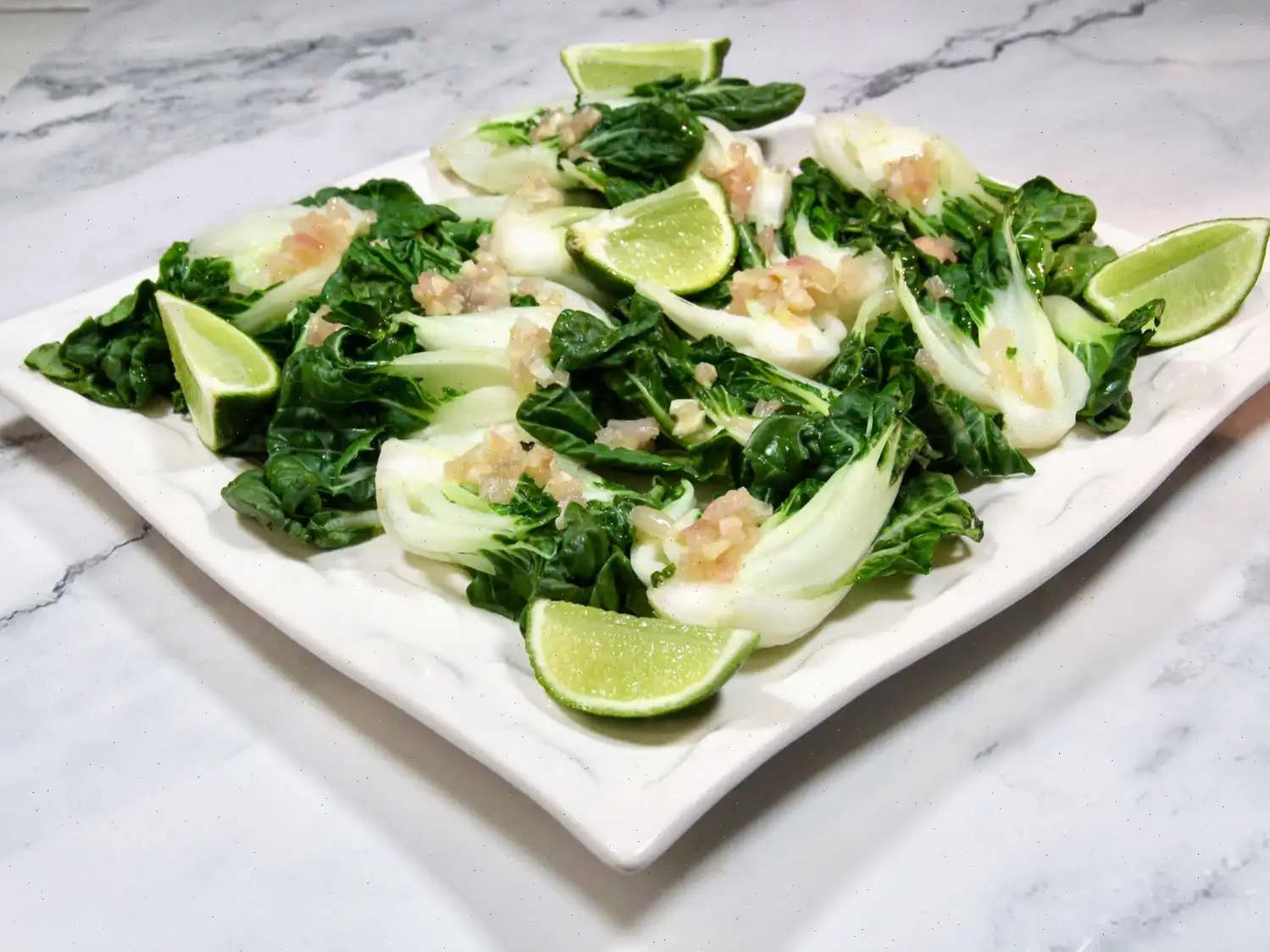
Steamed Bok Choy Recipe
Ingredients
This recipe was developed at its original yield. Ingredient amounts are automatically adjusted, but cooking times and steps remain unchanged. Note that not all recipes scale perfectly.
- 1 pound baby bok choy
- 1 tablespoon olive oil, plus more for drizzling
- 2 cloves garlic, minced
- 2 tablespoons minced shallots
- 2 tablespoons white vinegar
- Salt and freshly ground black pepper to taste
- 4 fresh lime wedges
Directions
- Remove any discolored outer leaves from the baby bok choy. Trim the bottom of the stalks, then slice the bok choy in half lengthwise.
- In a large pot, bring about 1 inch of water to a simmer over medium heat. Place a steamer basket into the pot and arrange the bok choy in the basket with the cut side facing up. Cover the pot and steam for 4 to 7 minutes, depending on the size of the stalks. To check for tenderness, insert the tip of a knife into the stem.
- While the bok choy is steaming, heat the olive oil in a small skillet over medium-low heat. Add the minced garlic and shallots to the pan, cooking for about 1 minute until fragrant. Stir in the white vinegar and cook for an additional 1 minute.
- Transfer the steamed bok choy to a serving plate. Spoon the garlic and shallot mixture over the top, then drizzle with a little more olive oil.
- Season with salt and pepper to taste, and serve the dish with a wedge of lime on the side.
Nutrition Facts (per serving)
| Calories | 71 |
|---|---|
| Total Fat | 4g |
| Saturated Fat | 1g |
| Cholesterol | 0mg |
| Sodium | 115mg |
| Total Carbohydrate | 10g |
| Dietary Fiber | 3g |
| Total Sugars | 2g |
| Protein | 2g |
| Vitamin C | 50mg |
| Calcium | 133mg |
| Iron | 2mg |
| Potassium | 513mg |

Steamed bok choy is a healthy, flavorful side dish that has roots in Asian cuisine, especially Chinese food. This recipe brings out the subtle sweetness and crunch of bok choy while infusing it with the savory richness of garlic, shallots, and the tang of lime and vinegar. It's a simple, but satisfying dish that pairs perfectly with both meat and vegetarian meals.
Origin of Bok Choy
Bok choy, known scientifically as Brassica rapa subsp. chinensis, is a type of Chinese cabbage. Its name, "bok choy," is derived from Cantonese, meaning "white vegetable," referring to its pale stems. It has been cultivated in China for over 5,000 years and spread across Asia and eventually the world. The vegetable is a key ingredient in Chinese and other East Asian cuisines, where it is used in a wide variety of dishes, from stir-fries to soups.
Regional Variations
While bok choy is a staple in Chinese cuisine, it is also widely used in other Asian countries such as Korea, Japan, and the Philippines. In Korea, bok choy is often used in stews, while in Japan, it might be added to noodle soups or served as part of a bento box. In Southeast Asia, especially in the Philippines, it is found in dishes like "sinigang" (a sour soup) and "adobo" (a savory stew). Regional differences in the preparation of bok choy often reflect local culinary traditions and flavor profiles, such as the use of different spices, broths, or seasonings.
What Sets Steamed Bok Choy Apart
Steamed bok choy, as the name suggests, is cooked by steaming rather than stir-frying or boiling. This technique preserves the vegetable's delicate texture, allowing it to retain its crispness and vibrant color. Unlike stir-fried bok choy, which is usually sauted with oil and seasonings at high heat, steaming offers a healthier alternative by requiring minimal fat and preserving the vegetable's natural flavor. The addition of garlic, shallots, vinegar, and lime enhances the dishs freshness with layers of savory, tangy, and citrusy notes.
Where is Steamed Bok Choy Typically Served?
Steamed bok choy is often served as a side dish in both Asian and Western cuisines. In Chinese restaurants, it is commonly found as part of a larger meal, accompanying meats like pork, chicken, or beef. In the United States and other Western countries, it has become a popular side dish in health-conscious restaurants, where it is served alongside grilled meats, fish, or tofu. Its light, fresh flavor makes it an ideal complement to more hearty or rich dishes.
Fun Facts About Bok Choy
- Bok choy is rich in nutrients, including vitamins A, C, and K, as well as calcium and iron. It's a low-calorie, high-fiber food that's perfect for a healthy diet.
- The vegetable is also known for its detoxifying properties, as it helps support liver function and digestion due to its high water content and fiber.
- Bok choy is one of the most widely grown vegetables in China, and it has been a key ingredient in Chinese medicinal food practices for centuries.
- In the 19th century, Chinese immigrants brought bok choy to the United States, where it eventually gained popularity among health-conscious consumers.
You can listen to this recipe in AI audio format. Simply click the play button below to listen to the content in a format that suits you best. It’s a great way to absorb information on the go!








